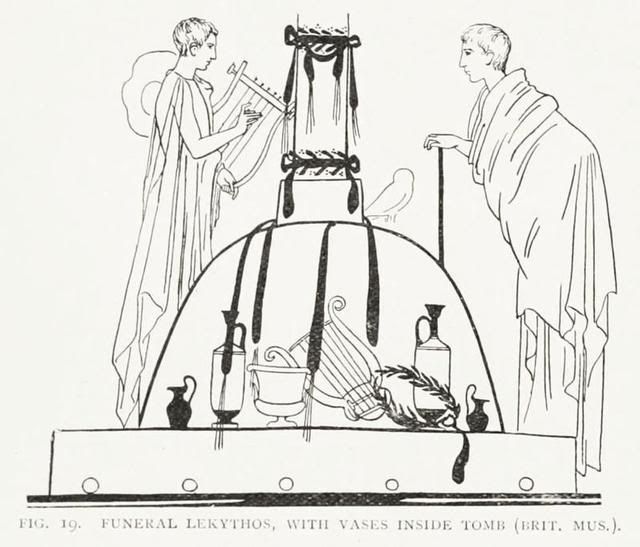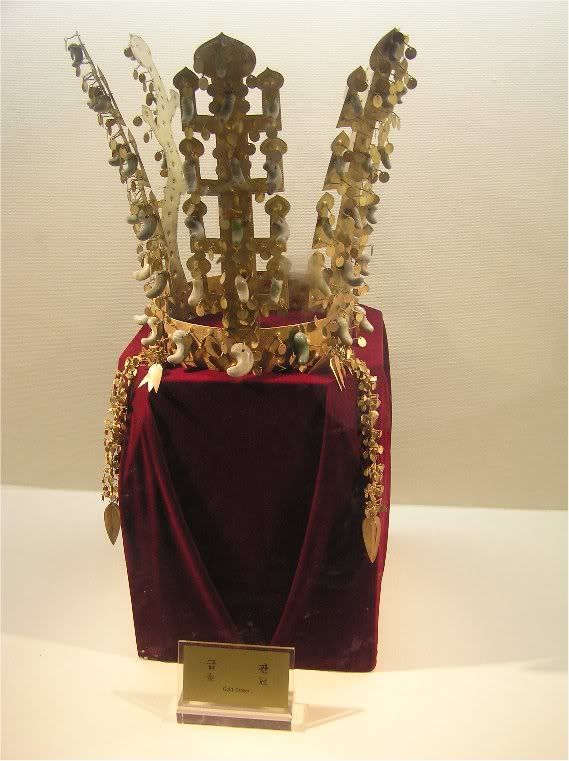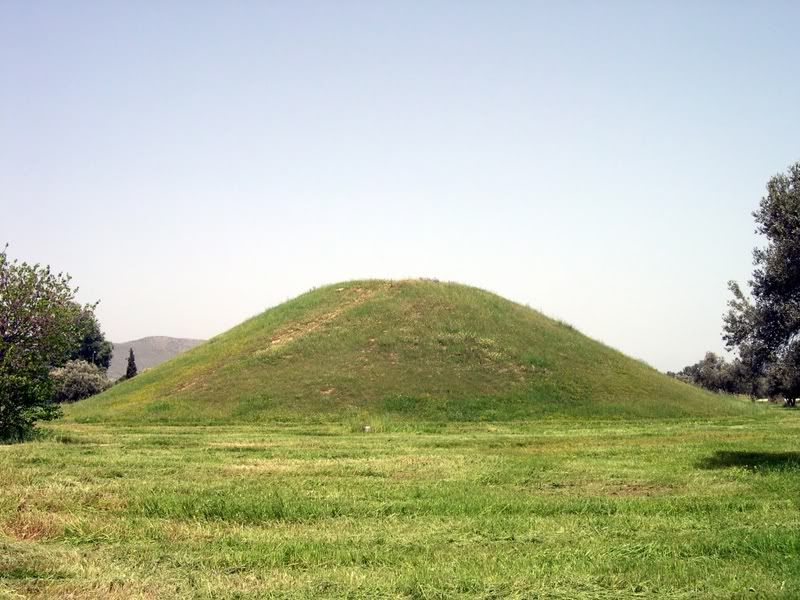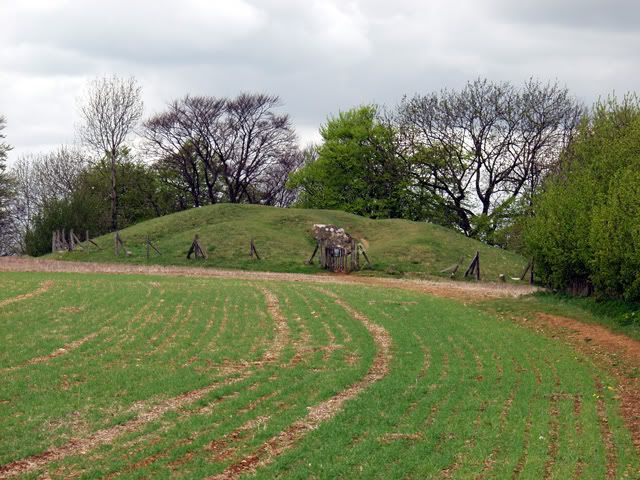
The Ramabhar Stupa (or Rambhar Stupa, Adhana Stupa), in Kushinara (Kushinagar), Uttar Pradesh, India. This Stupa was built over a portion of the Buddha's ashes, by the ancient Malla people. Photo by Bpilgrim, 2007.
Stupa are related to early Buddhism and similar traditions as with Stupas and burials are found in archaic Europe, i.e. in ancient Greece and Rome before christianizing. So were the tumuli (barrow) graves. Similar ancient culture was practiced in a huge area (with a few local variations).

The photo is a painting on a Greek Lekythos Vase that is exhibited at the British Museum. It shows a funeral and the interior of a conical tomb, a tumulus. The ashes of a person were placed inside such a tumulus of ancient Greece.
Stupas and Tumuli was additionally found as part of the grassland Central Asian cultures, such as in the cultures of the Scythian or the Kurgan: Tumulus
It is not correct as is written in this linked Wapedia article: All these tumuli or grave barrows around Europe are not of Scythian or Kurgan origin or related to Scythians or Kurgans.
The Scythian or Kurgan Culture is specific in its expression and is documented most frequently on the Central Asian Steppes, as far east as Mongolia. They were tall horse nomadic people with very characteristic cultural expressions e.g.: Tattoos, they had particular burial traditions. The Scythian Tumulus graves were in general much larger than the ones common in Europe. Physically the Scythians generally had a tall body stature and blonde hair (as can be seen in the remains of the ancient mummies).
As mentioned other ancient cultures in Europe also had the traditions of building Tumulus graves. You can see some places in the Videos under.
In many of these places such as in Scotland and in the Nordic area there are no archaeological findings that clearly link this ancient cultural expression to the culture of the Scythian / Kurgan people.
For instance in Scotland this culture is related to Euro-Asiatic people that both inhabited the Nordic and the European continent. In the Nordic areas this tradition with tumulus graves / barrows is related to religious ceremonies of the people of Lapland, see following link were you can find sources:
Nordic Sami men worshipping a the Thunder God Thoragalles on top of a large tumulus
Nordic Sami people is worshipping an ancient God on a smaller tumulus or barrow
Tumuli Stupa in Baramulla, Jammu & Kashmir
Tumuli Groups, Noto Peninsula Japan
Tumuli, Daegu in South Korea

Silla crown found in Southern Korea. The gold crown excavated from the Heavenly Horse Tomb. Southern Korea. Photo by NW-Photos.com, 2006.
Etruscian Tumuli (grave mound) - Italy

Tumulus Marathon, Greece. Funeral tumulus of the Athenians. Photo by Dgcampos, 2008
Tumulus (Burial mound) in Athens Greece

Hetty Pegler's Tump- geograph.org.uk 3133. Situated right in the SE corner of the grid square is this ancient longbarrow. photo by Alan Simkins, 2003.
The Garth Mountain Tumulus in Cardiff, UK.
The Hill of Tara in Scotland - ancient tumulus of the pre-christians
Tumulus - Курганы – Barrows - gravhauger Ukraina, Zaporozhye
Dolmens and Tumuli in Emmerdennen Hunebed, Drenthe in Netherlands
http://www.youtube.com/watch?v=dJr_sa6nBck
Nordic Sami people is worshipping an ancient God on a smaller tumulus or barrow
UNDER CONSTRUCTION: [I will add more photos and literature sources]
A Buddhist stupa mound near Baramulla in Jammu and Kashmir, taken by John Burke in 1868. Buddhism was established in Kashmir from the 3 century BCE. In 7th century a Chinese munk Hieuan Tsang described Ushkur in Kashmir as a flourishing Buddhist centre.
During the 8 th Century CE Buddhism declined. Two important Buddhist sites in the Kashmir valley are Harwan near Srinagar and Ushkur near Baramulla (55 km north of Srinagar). The ancient site of Hushkapur (now Ushkur) is said to have been founded by Huvishka (Kushana dynasty) that ruled portions of Afghanistan and India during the first 3 centuries CE. This general view of the unexcavated stupa is reproduced in Henry Hardy Cole's Archaeological Survey of India report, 'Illustrations of Ancient Buildings in Kashmir,' (1869). Hardy wrote: "The locality which includes the remains of a Monastery is called the 'Jayendra Vihar', and the erection is assigned by local tradition to one 'Praverasena' in A.D. 500. Excavation required." In this mound they excavated stupa bases, finely modelled terracotta heads and different other remains (source: Wikimedia).
During the 8 th Century CE Buddhism declined. Two important Buddhist sites in the Kashmir valley are Harwan near Srinagar and Ushkur near Baramulla (55 km north of Srinagar). The ancient site of Hushkapur (now Ushkur) is said to have been founded by Huvishka (Kushana dynasty) that ruled portions of Afghanistan and India during the first 3 centuries CE. This general view of the unexcavated stupa is reproduced in Henry Hardy Cole's Archaeological Survey of India report, 'Illustrations of Ancient Buildings in Kashmir,' (1869). Hardy wrote: "The locality which includes the remains of a Monastery is called the 'Jayendra Vihar', and the erection is assigned by local tradition to one 'Praverasena' in A.D. 500. Excavation required." In this mound they excavated stupa bases, finely modelled terracotta heads and different other remains (source: Wikimedia).
Buddhismen ble etablert i Kashmir fra det tredje århundret før vanlig tidsregning. I det syvende århundret rapporterte Hienuan Tsang (en kinesisk munk) at Ushkur i Kashmir var et blomstrende buddhistisk senter. I løpet av det 8 århundret var Buddhismen nedadgående. To viktige buddhistiske steder i Kashmir er Harwan nær Srinagar og Ushkur nært Baramulla (55 kilometer nord for Srinagar). Et eldgammelt sted er Huskapur (nå Ushkur) som sies å være etablert av Huvishka (Kushan dynastiet) som regjerte over deler av Afghanistan og India i de tre første århundrene av vanlig tidsregning. Dette bildet viser en uåpnet stupa som ble rapportert i Cole's Archaeological Survey of India report, av Henry Hardy: 'Illustrations of Ancient Buildings in Kashmir,' (1869). Hardy skreiv at denne stupa er en rest etter et kloster kalt "Jayendra Vihar" og dens form var lokal tradisjon i Praverasena 500 CE. I denne gravhaugen fant man grunnpilarer av stupa, fint modellerte terakotta hoder, og forskjellige andre rester (kilde: Wikimedia).
Stupa, Stupas in India
Asuka period - Kitora Tomb in Japan
http://www.youtube.com/watch?v=WK3cAsqkTNs
Kitora Tomb in Japan are ancient Star charts found. The Asuka period was between 7th and 8th century CE according to this article By Steve Renshaw and Saori Ihara.Dette gravkammeret i Kitora i Japan inneholder eldgamle stjernekart. Asuka perioden i Japan var mellom 7 - 8 århundrer CE. Se artikkel i lenken over. I de ulike videoene kan man i tillegg til Stupa former i India se gravhauger fra ulike steder på kloden for eksempel: Japan, Sør-Korea, Italia, Bosnia, Frankrike, Hellas, Tyrkia, Ukraina, Makedonia, England, Scotland, Irland, Spania, og Nederland. I tillegg så vet vi at slike finnes også i hele Norden og i Russland.
Kitora Tomb in Japan are ancient Star charts found. The Asuka period was between 7th and 8th century CE according to this article By Steve Renshaw and Saori Ihara.Dette gravkammeret i Kitora i Japan inneholder eldgamle stjernekart. Asuka perioden i Japan var mellom 7 - 8 århundrer CE. Se artikkel i lenken over. I de ulike videoene kan man i tillegg til Stupa former i India se gravhauger fra ulike steder på kloden for eksempel: Japan, Sør-Korea, Italia, Bosnia, Frankrike, Hellas, Tyrkia, Ukraina, Makedonia, England, Scotland, Irland, Spania, og Nederland. I tillegg så vet vi at slike finnes også i hele Norden og i Russland.
Tumuli Groups, Noto Peninsula Japan
http://www.youtube.com/watch?v=wZduhO7nrrs
Kofi Kofun Gal, Haniwa, Japan. With ancient zodiac animals.
Kofi Kofun Gal, Haniwa, Japan. With ancient zodiac animals.
http://www.youtube.com/watch?v=pJ_-MojvCJM
Tumuli, Daegu in South Korea
with finds of e.g. Glass, Gold, fine Ceramics, golden jewelry and crown, and a mural painting on birch bark of a winged horse.
http://www.youtube.com/watch?v=KVdzKw9JSyQ

Silla crown found in Southern Korea. The gold crown excavated from the Heavenly Horse Tomb. Southern Korea. Photo by NW-Photos.com, 2006.
Etruscian Tumuli (grave mound) - Italy
- cerveteri, necropoli della banditaccia
http://www.youtube.com/watch?v=5FUVZX0jkZo
Keriaval in Normandie, France.
Keriaval in Normandie, France.
Carnac & Morbihan: Megaliths and Sacred sites.
http://www.youtube.com/watch?v=F1-ilqyNSIE
Tumulus of Calismasi, Bosnia.
Tumulus of Calismasi, Bosnia.
Vergina is close to the ancient site of Aigai or Aegae, Macedonia.
The royal capital of ancient Greek Macedonia. which was ruled by the Argead dynasty from about 650 BCE. A larnax gold casket the remains of Philip II has a symbol of a sun or star on its lid, and this Vergina Sun has been adopted as a symbol of Greek Macedonia. Read more under the video at Youtube.
http://www.youtube.com/watch?v=F2OJE655Rfs
Turkey - Lidya (Near the Black Sea)
Çukuru Tümülüs- Pre-Christian culture of Turkey
Turkey - Lidya (Near the Black Sea)
Çukuru Tümülüs- Pre-Christian culture of Turkey
http://www.youtube.com/watch?v=Rpl0Lw_CzLI

Tumulus Marathon, Greece. Funeral tumulus of the Athenians. Photo by Dgcampos, 2008
Tumulus (Burial mound) in Athens Greece

Hetty Pegler's Tump- geograph.org.uk 3133. Situated right in the SE corner of the grid square is this ancient longbarrow. photo by Alan Simkins, 2003.
The Garth Mountain Tumulus in Cardiff, UK.
The Hill of Tara in Scotland - ancient tumulus of the pre-christians
http://www.youtube.com/watch?v=MG3wWfjxg8M
Dolmens and Tumuli of Vervant, South Western France
Dolmens and Tumuli of Vervant, South Western France
http://www.youtube.com/watch?v=8CoKCGUhKLI Photos and more videos in Blog
Rutas megaliticas, Extremadura, Spain
Rutas megaliticas, Extremadura, Spain
Tumulus - Курганы – Barrows - gravhauger Ukraina, Zaporozhye
Dolmens and Tumuli in Emmerdennen Hunebed, Drenthe in Netherlands
http://www.youtube.com/watch?v=dJr_sa6nBck


Awesome blog!
ReplyDeleteHere are some tumuli from the southern part of Romania:
http://www.youtube.com/watch?v=JVnbqOzQaQo
Tumuli in Bistret, Dolj, Romania
excellent description and comparison.
ReplyDelete